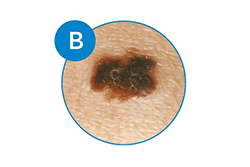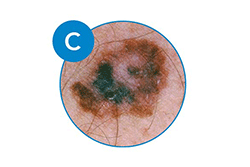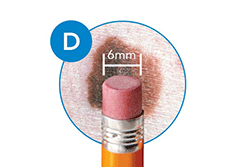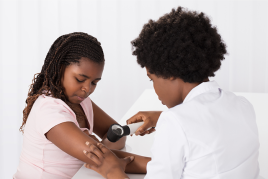What to look for: ABCDEs of melanoma
Download the AAD's body mole map to note the results of your self-examination. Consult your dermatologist immediately if any of your moles or pigmented spots exhibit:
 | A is for Asymmetry One half of the spot is unlike the other half. | |
 | B is for Border The spot has an irregular, scalloped, or poorly defined border. | |
 | C is for Color The spot has varying colors from one area to the next, such as shades of tan, brown or black, or areas of white, red, or blue. | |
 | D is for Diameter While melanomas are usually greater than 6 millimeters, or about the size of a pencil eraser, when diagnosed, they can be smaller. | |
 E is for Evolving The spot looks different from the rest or is changing in size, shape, or color. | ||
Learn how the ABCDEs of melanoma were created
The history behind the of ABCDEs of melanoma
Darrell Rigel, MD, explains why dermatologists created the ABCDEs of melanoma.
How to check your skin for skin cancer
Follow these tips from board-certified dermatologists to increase your chances of spotting skin cancer early, when it’s most treatable.
If you notice any new spots on your skin, spots that are different from others, or spots that are changing, itching or bleeding, make an appointment to see a board-certified dermatologist.
FIND SKIN CANCER: HOW TO PERFORM A SKIN SELF-EXAM
Regularly checking your skin can help catch skin cancer early, when it’s highly treatable. Follow these tips from board-certified dermatologists to check your skin for signs of skin cancer.
 Molluscum contagiosum: How to safely treat it
Molluscum contagiosum: How to safely treat it
 Biosimilars: 14 FAQs
Biosimilars: 14 FAQs
 Practice Safe Sun
Practice Safe Sun
 Relieve uncontrollably itchy skin
Relieve uncontrollably itchy skin
 Fade dark spots
Fade dark spots
 Untreatable razor bumps or acne?
Untreatable razor bumps or acne?
 Laser hair removal
Laser hair removal
 Scar treatment
Scar treatment
 Botox
Botox
 Free materials to help raise skin cancer awareness
Free materials to help raise skin cancer awareness
 Dermatologist-approved lesson plans, activities you can use
Dermatologist-approved lesson plans, activities you can use
 Find a Dermatologist
Find a Dermatologist
 What is a dermatologist?
What is a dermatologist?